Routine Tooth Fillings
The question dentists are most commonly asked is 'Do I need any fillings?'
We recommend a filling if you have new tooth decay which has developed into a cavity and needs to be fixed or if an older filling needs to be replaced, usually due to tooth decay around its edges or if it has fractured.
Most fillings are made from either amalgam (silver/dark colour) or composite resin (tooth coloured). Great advances have been made in improving the strength of composite materials in the last twenty years and lots of the research shows them to be as strong as the traditional amalgam filling. However alot depends on the situation for which the material is used as the techniques used to place the fillings are very different. Composite (white) filling material is suitable for use in smaller cavities (holes), usually confined to one or two tooth surfaces. If at all possible, it is used for all teeth visible when you smile. Attention to detail is key in providing you with a great filling that blends well with the colour of your tooth and will last for many years. Unfortunately, due to material costs and the greater time they take, composite fillings are slightly more expensive than amalgam.
For larger fillings, an excellent cosmetic option is a porcelain inlay or onlay about which you can read in another section. A well–placed amalgam filling is an excellent option if you are not too concerned about the tooth's appearance, eg an upper molar tooth, but are looking for strength and durability. Because amalgam contains mercury among other metals, it receives a lot of unfounded bad press. However, extensive research over many years has shown amalgam to be a very safe material.
At Oranmore Dental Care, we assess each situation carefully and discuss your options with you.
Options to consider when choosing a filling type:
| Amalgam Fillings | |
|---|---|
| Colour | Silver when placed, looks darker over time. |
| Cost | Less expensive. |
| Strength | Very strong, can withstand heavy biting and can last many years (20+). |
| Method | Filling is packed into tooth and shaped. Sets over several hours after. |
| Tooth Structure | For very small cavities, sometimes you cut away extra tooth to allow placement of the filling. |
| Composite Fillings | |
|---|---|
| Colour | White/Tooth coloured. |
| Cost | More expensive as takes more time to place and material more expensive. |
| Strength | Strong but not as strong as amalgam on larger fillings for back teeth. |
| Method | Filling is bonded to the tooth and light - cured (sets immediately). Technique more sensitive to moisture – requires greater attention to detail. |
| Tooth Structure | Suitable for placing in small cavities/ tight spaces. Conserves tooth structure. |
Back to top
Cleaning & Gum Treatments
Tooth cleaning is carried out to remove stains (tea, coffee, wine, smoking), remove plaque (soft layer of germs/food particles on the tooth surface) and to remove tartar (also called calculus, a hard material, stuck to the tooth like a cement). Different people have very different needs when it comes to tooth cleaning.
Your level of need depends on:
- How well you clean your teeth yourself.
- Whether or not you smoke, drink tea/coffee.
- Whether or not your mouth tends to make plaque or tartar easily.
- Whether or not you are susceptible to gum disease (some people are genetically more prone than others).
- Your general health, many medical conditions make you more likely to develop gum problems.
Therefore tooth cleaning needs can vary from a once yearly simple 'scale and polish' to needing several visits to our dental hygienist for more intensive cleaning of 7-8 teeth at a time.
Our aim is to help you be someone who only needs a simple cleaning once or twice per year.

The customer who attends for a scale and polish is usually concerned about the stains or tartar they can see on their teeth, i.e. what is visible above the gumline. However we as dentists and hygienists are equally concerned about the buildup of hard tartar on the root surface of your tooth. It is this buildup of debris below the gumline which causes problems with gum disease. Gum disease affects about 70% of the adult population to varying degrees and is the most common cause of loss of teeth later in life.
For more info on gum disease, read our information in the Advice page.
Back to top
Root Canal Treatment
A Root Canal Treatment is required to keep a tooth if the nerve and blood supply (dental pulp) to that tooth has been damaged. This damage can be due to trauma (breaking a tooth), tooth decay (bacteria damages the pulp), or a dental abscess (infection in the root canal space and surrounding bone).
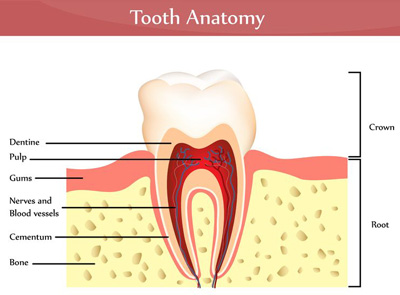
What does it involve?
First the tooth is thoroughly numbed and a rubber dam cover is placed on the tooth. Then a hole is made in the tooth to locate the pulp or root canal space which is right in the middle. Fine instruments are used to clean the space and shape it all the way to the tip of its roots. The space is then washed, dried and sealed with a rubber – based material. The whole procedure is usually completed in 1.5-2 hours, over one or two appointments.
Afterwards the tooth is restored with a filling, often followed by a crown to protect it from fracturing.
Is it painful?
Many people have heard that root canal treatments are very painful and this puts them off having the treatment. The procedure itself is not painful and we make sure the tooth is as numb as possible. However, the tooth is often causing pain beforehand and may be tender for a few days afterwards.
How do I know I need a Root Canal Treatment?
You may have a toothache, varying from a constant dull ache to throbbing pain. The tooth may be tender to touch or bite. It may also be particularly sensitive to hot and cold food or drinks, with a lingering ache afterwards.
Sometimes a tooth which needs a root canal treatment does not show any symptoms over many years but shows a clear shadow over the root of the tooth when an xray is taken. This can come as an unexpected surprise but is sometimes necessary especially if other work is been considered for the tooth, for example a crown.
Why are Root Canal Treatments expensive?
Every tooth has a unique root canal shape. This shape must be carefully explored, shaped and repeatedly cleaned with disinfectant material and very fine instruments to eliminate all bacteria and toxic material. When this is completed, the root canal space is then carefully packed, millimetre by millimetre, with the root canal filling material. All this takes time, requiring long appointments, and taking shortcuts with that time compromises the success rate. At the end of the day, we want to achieve a successful result without compromising the quality of treatment delivered.
The instruments used are also highly refined and expensive. At Oranmore Dental Care, for your protection, all these instruments are single-use, ie new instruments used for each treatment.
Back to top
Tooth Whitening
Professional Tooth whitening is a safe, non-invasive treatment used to brighten the natural shade of your teeth. The natural shade of our teeth varies from person to person. Some people are lucky enough to have naturally white teeth while others have a more yellow hue.
Over time teeth can become discoloured due to:
- Age - Our teeth become more yellow with age.
- Lifestyle - Stains build up on our teeth from wine, tea, coffee and smoking.
- Trauma - Individual teeth can become grey if they have been injured in the past or have required root canal treatments.
How does tooth whitening work?
A tooth whitening gel is applied to the surface of the teeth covered by a custom made whitening tray. When it is left on the surface for a period of time, the whitening ingredients penetrate the tooth and lighten the colour. This technique has been shown to be perfectly safe when done under professional guidance. It does not damage the tooth surface or structure in any way. We provide you with the bleaching gels and make the trays for your mouth. These are light, fit snugly and are easy to tolerate. We usually recommend that you whiten your teeth overnight. This gives the gels several hours of contact with the tooth surface and is convenient.
How long will it take?
Usually you start to see an improvement after 3-4 applications. Most people get the result they want after about 10 applications. It all depends on the shade of your teeth when you start and on what your own expectations are. Having whiter teeth will not make your teeth less likely to stain due to tea, coffee, smoking, etc. In fact, stains will show up easier on a whiter background. Therefore excellent care for you teeth is an important part of this treatment.
How long will it last?
The whitened effect usually lasts about 1-2 years, sometimes longer. There is no way of predicting how long the effect will last. It is then easy to do a short course of whitening to 'top-up' the effect. You already have the custom trays so you just purchase some bleaching gel.
Does it hurt?
Your teeth may become temporarily sensitive during the treatment. Again this varies from person to person. Cold and hot food, or a sharp intake of air when outside, can irritate the teeth. It usually settles after about 24 hours. In a small number of cases, this sensitivity can last longer but usually not more than 3-4 days.
Does it work for crowns and white fillings?
Unfortunately, any tooth coloured dental work in your mouth will not whiten. If you have white fillings, crowns or veneers on your front teeth, you may have to consider replacing them after the whitening procedure. If you are planning to replace a white filling, crown or veneer, we recommend that you whiten your teeth first so the shade of the restoration (dental work) will match your new tooth colour.
Back to top
Tooth Removal
We always try to preserve a tooth if possible but sometimes it is necessary to remove it. This is called a dental extraction. The most common causes of tooth removal are severe tooth decay, a dental abscess, looseness due to gum disease or trauma. Before removing a tooth, we take an x-ray to assess the shape of the tooth and its roots, and the structures around the tooth and how they might impact on the procedure. In most cases, a tooth is removed whole (in one piece). Sometimes the shape of the tooth's roots or the location of tooth decay means it is easier to carefully divide the tooth into two or three sections and then remove each one. This is called a surgical extraction.
We will always assess the likely difficulty of a tooth extraction and discuss it with you before going ahead. In most cases the procedure is straight-forward and is completed in a 30 minute visit. Occasionally, we place a couple of sutures (stitches) after an extraction. Requiring stitches is not something to be very concerned about. They simply allow us to close the wound better which will assist the healing process. We usually place stitches which fall out themselves. We complete the vast majority of dental extractions required by our patients within the practice and all have lots of experience in completing them.
Wisdom Teeth:
Wisdom teeth come in all shapes and sizes and grow into the mouth in a variety of positions. They usually appear between the ages of 17 -21 years. Not everyone develops all four wisdom teeth. The main problems which occur are associated with having a lack of space for the tooth to erupt (position itself in the mouth) fully. The tooth is then caught in a position where it has a flap of gum sitting over it. Bacteria can get under the gum and cause an infection called pericoronitis. This tends to occur more commonly with the lower wisdom teeth.
In most cases the upper wisdom teeth grow fully into the mouth but they often lean outwards towards the cheek instead of in line with the other molar teeth. This can cause problems because they are difficult to keep clean and develop tooth decay or gum disease problems as the years pass by.
If your wisdom teeth are growing into your mouth, make a good effort to clean them thoroughly with your toothbrush to avoid infection related problems. If the gum becomes painful, simply rinsing your mouth several times per day with a pinch of salt in warm water and cleaning all your teeth thoroughly can be enough to reduce the inflammation. If that does not control it, you should make a dental appointment to get them checked. If there is acute infection, we may prescribe an antibiotic.
Removal of Wisdom teeth:
If a wisdom tooth is causing repeated episodes of pain or it develops disease or its position causes problems for adjacent teeth, then it is wise to have it removed. In many cases this is a normal tooth extraction, not much different to any other tooth.
If the tooth is in a difficult position or has a tricky root shape, then the extraction may be more complicated. This occurs more commonly with the lower wisdom teeth and is carefully assessed beforehand with an x-ray. Sometimes it makes sense to have the tooth removed under general anaesthetic or sedation. This applies mainly if more than one tooth needs to be removed. If this is the case, we will refer you to a suitably qualified oral surgeon for your care.
Back to top
Crowns, Onlays & Veneers
This type of restoration is used to repair a tooth which has a large cavity involving two or more surfaces, without having to replace the entire outer portion of the tooth like a crown. This conserves the tooth structure and because they bond very well to that surface, can contribute to strengthening the tooth.
Making an onlay involves two visits to the dentist. At the first visit, we prepare the tooth and take impressions (a mould of your teeth). At the end of that visit you go home with a temporary restoration on the tooth. The impression is then sent to a dental technician who uses it to make a stone model and construct the porcelain onlay. At your second visit, we fit the onlay and provided it fits well, we then bond it to your tooth and finish by polishing it thoroughly.
Porcelain onlays are a great alternative to a conventional white composite filling, especially if the cavity involves several surfaces. This is because the composite fillings shrinks when you place it in the tooth, which can cause problems when that filling is large. Because the onlay is made outside the mouth, there is no such shrinkage. The porcelain material is also stronger over time that composite.
They are also a great alternative to a crown if the visible (in your smile) surface of the tooth is in good condition because they involve simple refining of the existing cavity rather than removal of further tooth structure.
Because a porcelain onlay involves two visits and a dental laboratory process, it is significantly more expensive than a regular filling. It is however less expensive than a crown.
Crowns
A crown is a false shell of porcelain and/or metal cemented over the top of an existing tooth. It is used to restore a tooth if it missing a large amount of tooth structure and protects the root from fracturing.
A crown is made by a dental technician so the process involves two visits to the dentist. The first visit is longer and busier. We numb the tooth prepare it for the crown, take impressions (imprints) of your teeth and you leave that day with a temporary crown in place. The impressions are sent to a dental technician and the crown is made.
At the second visit, we fit the crown. If it fits perfectly and we are all happy with the appearance, the crown is cemented into place and cannot be removed easily after. For crowns which are cosmetically important, i.e. at the front of the mouth, it may take extra visits to get the shape and shade of the tooth absolutely right.
Veneers
A veneer is a thin layer of porcelain which is used to change the shape, shade or angle of an existing tooth or several teeth. They usually require the removal of a thin layer of enamel from the front of the tooth. The tooth needs to be in reasonably good condition to be suitable for a veneer.
Back to top
Missing Tooth Replacement
Missing teeth can be replaced by a bridge, implants or a denture. A bridge or implant is designed so that it is fixed in place so it cannot be removed at home. A denture can be removed at home.
Bridge:
A bridge is a false tooth or teeth supported by neighbouring teeth. To assess whether a gap you have is suitable we must first assess the teeth which would support a bridge and see whether they are suitable support teeth (we call these abutments). It is then decided whether that support will be by crowning the tooth (conventional method) or placing a metal wing on the back of the tooth (Maryland method).
A bridge is made in a similar way to a crown. On the first visit, the supporting teeth are prepared and impressions are taken. These impressions are sent to a dental technician who constructs the bridge. On the second visit the bridge is fitted in place. If any adjustments are required, a third visit or more may be required to get it just right. When everyone is satisfied, the bridge is cemented in place and we show you how to clean around it.
Dental Implant:
An implant is like a metal screw which is placed into the bone where you have a space. It is left in place for a few months and the bone grows around the implant. This is called integration. Once the implant is integrated, we can the take an impression of the area and a dental technician makes the crown and a connecting piece (called an abutment). These are connected to the implant via a small screw.
A dental implant is particularly suitable for a space where the neighbouring teeth are in perfect condition as it avoids the tooth drilling that is involved in a bridge.
Dental implants are a fantastic new technology, which have many uses in the mouth. As described above, they can be used to replace one or more missing teeth. They can also be used to support a bridge if several teeth are to be replaced. They can also be used to support a denture and are particularly helpful for supporting a full lower denture, giving it good stability in the mouth, and comfort and confidence to its wearer.
| Examples of Dental Implants | |
|---|---|
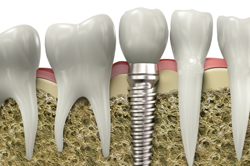 |
This image illustrates a single tooth implant in the bone with a crown attached. |
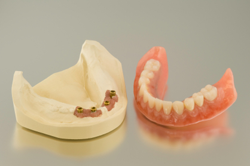 |
This image shows a technician's model with four implants to which a full lower denture clips to assist with holding it in place in the mouth. |
Dentures
Dentures come in all shapes and sizes. They can be used to replace a single tooth (this is usually a temporary method before progressing to a bridge or an implant), several teeth or can replace all teeth.
A denture can be made from all acrylic which is pink in colour with teeth attached, or can have a metal framework made from chrome-cobalt with pink acrylic and teeth attached. A chrome-cobalt denture has the advantage that it is supported by the teeth, feels more stable and tighter in the mouth and does not cause damage to the gums which can be caused by an all-acrylic denture. A chrome-cobalt denture can be an excellent alternative to bridges or implants if there are several gaps to fill.
| Examples of Dentures | |
|---|---|
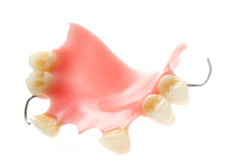 |
This is an acrylic denture for some missing upper teeth. It is held in place by fitting between the teeth. |
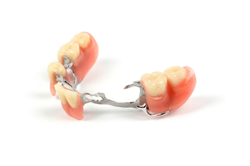 |
This is a chrome-cobalt denture for some missing lower teeth. Its design is more refined and is held in place by metal clasps. It is minimally visible when you smile. |
Back to top
